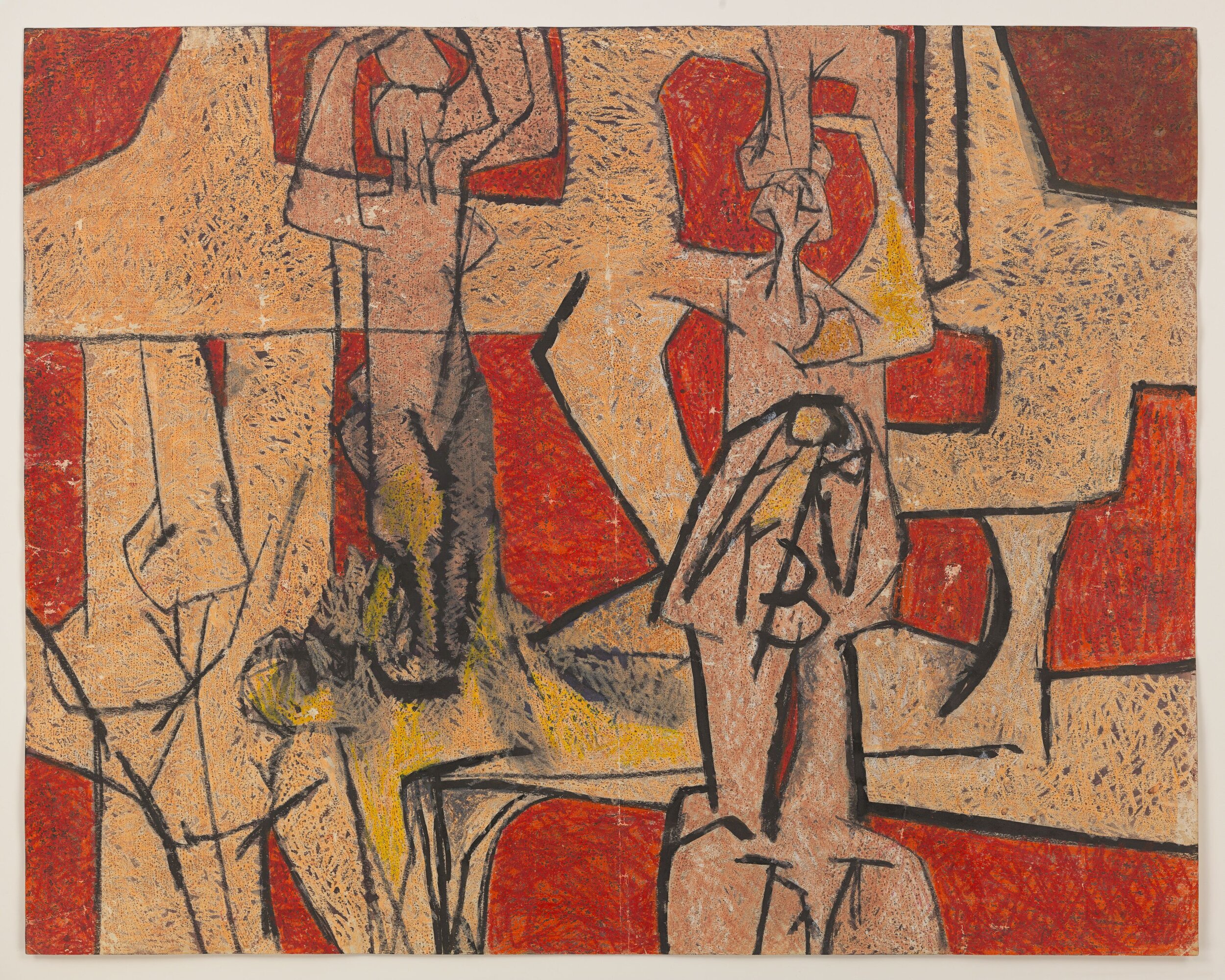Luchita Hurtado: A New Book by Hans Ulrich Obrist Offers a Glimpse into the Magical Life of the Artist
“I look at the moon like a fellow traveler.” Luchita Hurtado and Matt Mullican overlooking the Arizona landscape, 1961. © The Estate of Luchita Hurtado. Courtesy The Estate of Luchita Hurtado and Hauser & Wirth. Photo: Lee Mullican
Luchita Hurtado, a new book from Hauser & Wirth released on occasion of what would have been the artist’s 100th birthday, presents an intimate portrait of Hurtado’s life and work through a selection of never-before-seen photographs and art from her studio, as well as her own words in a conversation with friend and colleague, Hans Ulrich Obrist, Artistic Director at the Serpentine Galleries. A bitter-sweet tribute to her life (she passed earlier this year in August), the sentiment of this publication is thoughtfully defined by Obrist whose close relationship with the artist is made readily apparent.
Luchita Hurtado, Playa Najayo, Dominican Republic, 1940. © The Estate of Luchita Hurtado,Courtesy The Estate of Luchita Hurtado and Hauser & Wirth
Luchita Hurtado honors not only Luchita, the artist, but more importantly Luchita, the person— the woman, the friend, the confidant, the mother, the lover, the wife, the earth activist, the Venezuelan, the Angeleno, the planetarian. This book is a tribute to Luchita Hurtado (1920-2020) as a human being— her life, worth noting not only for her work and contribution to art history, but also the way she viewed and interacted with the world around her.
Obrist writes, “Luchita, during her entire life, found endless opportunities to gaze at the world with wonder.”
Luchita Hurtado and John Mullican, California, 1966. © The Estate of Luchita Hurtado. Courtesy The Estate of Luchita Hurtado and Hauser & Wirth. Photo: Lee Mullican
Untitled, 1971. Oil on paper. 77.5 x 64.8 cm / 30 1/2 x 25 1/2 in. Photo: Jeff McLane
From her series of self portraits which “explored the boundaries of where the self meets the world” and paintings which blurred the lines between abstraction and figuration, to her illustrations of light which she hoped would attract moths to her canvases, her work reflects a unique sense of wonder about the world and her belief in the interconnectedness of all life.
As a mother, her work was also very much centered in the beauty of everyday life and the domestic sphere. Her self portraits, especially those created in the 1970s, represent a successful subversion of the so-called ‘male gaze,’ presenting a refreshingly new viewpoint of women’s bodies that can only be witnessed by women themselves.
Untitled c. 1940s. Crayon and ink on board. 36.2 x 17.2 cm / 14 1/4 x 6 3/4 in47.6 x 29.1 x 3.8 cm / 18 3/4 x 11 1/2 x 1 1/2 in (framed) Photo: Genevieve Hanson
Untitled c. 1965. Oil on paper48.3 x 61 cm / 19 x 24 in
Untitled c. 1950-1951. Crayon and ink on paper. 58.5 x 73.7 cm / 23 x 29 in75.1 x 90.4 x 5.2 cm / 29 5/8 x 35 5/8 x 2 in (framed) Photo: Genevieve Hanson
Through a conversation between the artist and Obrist, we are able to glean the true beauty of her life, her sensitivity to the world around her and understanding of her place within it. In her accounting of the stories of her past, this book allows us to intimately witness the magic that surrounded her wherever she went and the presence she brought into every experience of her life.
Luchita Hurtado traces the artist’s story from her upbringing in Venezuela, to various adventures in New York, Mexico, California and New Mexico, and finally back to California, in Santa Monica, where she eventually settled in 1951. It accounts for her involvement in the artistic circles of the Surrealists, Dynaton group, Mexican muralists and her relationship with countless influential figures and celebrated artists of the 20th century including Leonora Carrington, Marcel Duchamp, Arshile Gorky, Frida Kahlo, Lee Krasner, Agnes Martin, Robert Motherwell, Isamu Noguchi, Man Ray, Mark Rothko, and Rufino Tamayo.
Front to back: Luchita Hurtado, Wolfgang Paalen, Jacqueline Johnson, and Gordon Onslow Ford, Mitla, Mexico, 1949. © The Estate of Luchita Hurtado. CourtesyThe Estate of Luchita Hurtado and Hauser & Wirth. Photo: Lee Mullican
Highlights include stories of mixing paints with Rufino Tamayo in the kitchen, foot massages from Marcel Duchamp, discussing dreams with Leonora Carrington, an invitation to pose nude for Man Ray alongside his wife in Los Angeles (she declined), her exploration of feminism and participation in the Los Angeles Council of Women Artists with Judy Chicago and a spontaneous trip to Mexico with Wolfgang Paalen, an artist whom she later married. It was there in Mexico where she learned to fly a plane through Chiapas, searched for Olmec faces in the jungle, and took up the medium of photography.
Hurtado’s life was nothing short of marvelous. However, it wasn’t without disappointment. Despite painting for nearly 80 years up until the age of 99, her work was rarely exhibited until the 1970s and even then, only sporadically. One exhibition she did participate in was “Invisible/Visible,” at the Long Beach Museum of Art in 1972, organized by Judy Chicago and Dextra Frankel.
Remarkably, Hurtado enjoyed the greatest success of her career in just the few, final years of her life, beginning with an exhibition of her work in a 2016 solo show at Park View / Paul Soto gallery in Los Angeles, then in the 2018 ‘Made in LA’ Biennial, and with subsequent exhibitions at the Serpentine Sackler Gallery in London (2019), the Los Angeles County Museum of Art (2020) and Hauser & Wirth New York (2020).
On living an extraordinary life, Hurtado said “the secret is feeling comfortable with wherever you are. I think that’s probably what it is. I’m comfortable. But I’ve also never said no to life.”
For more information on Luchita Hurtado, please visit hauserwirth.com







